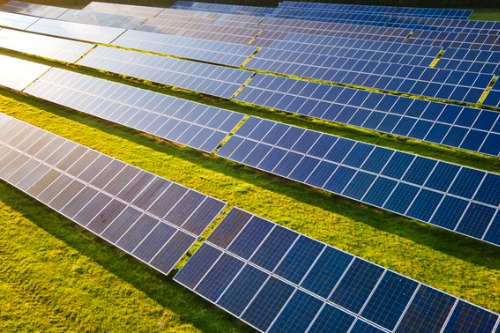HDI Global insight: Solar power shines ever brighter

Solar is an increasingly attractive option for industrial power. While there is still work to be done for it to fulfil its true potential, its continued growth means we may have hit peak emissions for global power.
For almost 20 years, solar power has been the world’s fastest-growing energy source. In 2022, global solar generation rose by 24 per cent and now accounts for 4.5 per cent of global electricity, according to a report by energy think tank Ember.
In some regions, recent growth has been even more significant: In 2022, European countries installed almost 50 per cent more solar power than they did in 2021. That included the continent’s largest solar plant. Located in southern Spain, the 590 MW Francisco Pizarro plant powers more than 300,000 homes. With almost 1.5 million photovoltaic modules, it covers an area the size of 1,300 football pitches.
Such impressive numbers will become increasingly commonplace in the next few years. According to the International Energy Agency (IEA), Russia’s invasion of Ukraine triggered the “first truly global energy crisis”, ensuring that growth in renewable capacity over the next five years will be much faster than many experts predicted just a year ago. In its Renewables 2022 report, the IEA now expects solar power capacity to exceed natural gas by 2026 and coal by 2027.
Solar an attractive option for industry
This is good news for the power-hungry industrial sector, which will have more opportunities to source electricity generated by renewable power plants. Iberdrola, which runs the Francisco Pizarro plant in Spain, has already signed power purchase agreements with companies such as Danone, Bayer and PepsiCo to supply solar-generated electricity to industrial sites.
Factories are also increasingly turning to rooftop solar to generate their own electricity. At Sumitomo Rubber Industries’ Falken Tyres plant in Thailand, work is underway to install 100,000 square metres of solar panels, which will be the world’s largest array on a single facility. China’s Huawei has agreed to install solar panels on 4,000 apparel factories in Bangladesh. And commercial buildings are also following suit. Siemens recently installed 1,400 solar panels atop New York’s Javits Center, making it Manhattan’s largest rooftop solar array.
According to CBRE, the potential benefits are considerable: A 2022 US market report said that solar systems can reduce a building’s reliance on grid-supplied electricity by as much as 80 per cent, and in many cases reduce electric bills by up to 95 per cent. In addition, the use of renewables can contribute to company ESG goals or to meeting the requirements of increasingly stringent public legislation.
Stumbling blocks to maximising potential
One of the key factors behind the rapid rise of solar has been a dramatic decrease in cost. In 2010, photovoltaic panels cost more than USD 2.00 per watt of electricity generated; in 2021, that cost had plummeted to just USD 0.27 per watt. This is mainly down to technological innovation and serious improvements in manufacturing efficiency, predominantly in China.
On the face of it, this may not seem concerning – cheaper solar panels are a good thing, after all. But the world will need a lot more solar panels in the coming years, and they can’t all be made in China. According to the IEA, China’s share in all the key manufacturing stages of solar panels exceeds 80 per cent. For key elements including polysilicon and wafers, this is set to rise to more than 95 per cent.
The risk of bottlenecks in the solar supply chain is a serious one that governments and industry need to address.
That isn’t the only obstacle to solar power reaching its full potential. Across the globe, “urgent work” is needed to ensure that solar power can be more smoothly integrated into the grid, says Ember’s report. This requires better planning permissions, grid connections, grid flexibility and market design. Meanwhile, the IEA believes faster growth would occur if European countries made it easier to obtain permits for new projects, improve incentives for rooftop solar installations and offer better terms in renewable energy auctions.
The darker side of solar
One of the most important questions facing the solar sector is what happens to photovoltaic panels when they reach end of life. Mostly made from glass, plastic, aluminium and silicon, they typically last 25 to 30 years. Given the nascent nature of the industry, most solar panels are yet to reach the end of their lifespan. As such, there is little infrastructure in place for recycling.
This needs to change. By 2030, there could be around eight million tonnes of decommissioned solar panels; in 2050, that number could reach 80 million tonnes. The few solar recyclers that do exist (there are just five in the United States, for instance) face significant economic, technological, and regulatory challenges. No surprise, then, that recycling rates are currently around just 10 per cent.
Have we hit peak emissions for the power sector?
While overcoming issues with the circular economy and supply chains are undoubtedly important, they are unlikely to put a serious brake on solar power’s continued growth. Solar isn’t just clean; it is also cheaper and more secure than fossil fuels in many countries – in addition to being faster and easier to install than wind turbines.
With electricity demand set to continue to rise, solar has a vital role to play in a new, cleaner global power system. Energy think tank Ember says the 2020s will be the “decade of implementation” for this system. “A new era of falling power sector emissions is close,” its report states. Indeed, 2023 may see a small fall in power generated by fossil fuels. That would make 2022 the year we hit ‘peak emissions’ for global power generation.
Authored by HDI Global




